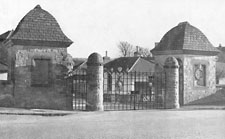Scottish History
The History of The Royal Scots
The Regimental Museum in Edinburgh Castle
Memorials
The Royal Scots Club

On 10th August 1922 HRH Princess Mary, Colonel in Chief, opened The Royal Scots Club in Abercromby Place, Edinburgh.

HRH Princess Mary
"We devoutly hope that by this club we can keep the memory of the 11,162 Royal Scots we mourn always before us. They gave up their lives so that those at home could live - they fought for their King and country. To all of us here we feel it a great honour that Your Royal Highness, the daughter of our King, should be with us today and take the leading part in this our tribute of love and respect to our fallen comrades." - Colonel Lord Henry Scott, Chairman of the Regimental committee.
Glencorse

The Royal Scots Regimental Depot was located at Glencorse Barracks from 1880 to 1960. It then became The Lowland Brigade Depot and is now The Army Training Regiment (Glencorse), The Scottish Division Depot. The gates at Glencorse Barracks were erected as a Memorial to those Royal Scots who died during the Great War 1914- 18. The money to pay for this memorial was raised through the generosity of serving and past officers of the Regiment, old Royal Scots and their friends. The memorial is in the form of wrought-iron gates, supported on circular stone pillars, flanked by small side gates, imposing stone gatehouses and outer wing walls. The opening ceremony was performed on 18 March 1927 by HRH Princess Mary, Colonel in Chief.
Scottish National War Memorial
This is located in Edinburgh Castle and each Scottish Regiment has its own memorial with rolls of honour.
Other Memorials
There are a considerable number of memorials to members of the Regiment in St Giles Cathedral and churches throughout the Regimental area. In Rosemount Cemetary, Leith there is a special memorial to those members of the 7th Battalion killed in the rail disaster at Gretna on 22 May 1915.
The Royal Scots Monument - Princes Street Gardens

The aim of the monument is to portray symbolically in stone and bronze the history of the Regiment from its earliest beginnings to modem times. Its principal feature is the large stone pylon facing diagonally towards the Castle which bears in its centre, the badge of the Regiment in bronze, on each flank of which the official battle honours of the Regiment are carved into the face of the stone. On the left of this principal pylon is a single monolith with carvings in low relief recalling the precursors of the Regiment in the days before it was formally raised as a Regiment by Sir John Hepburn under the authority of King Charles I in 1633. On the right of the principal pylon are six other similar monoliths widely spaced and illustrating in stone carvings the bearing, dress and equipment of Royal Scots at different representative periods in the three centuries of their eventful history. The large pylon and the monoliths are linked by a low bronze grille bearing in its course medallions of the Kings and Queens who have reigned since the foundation of this, The Royal Regiment. Above these medallions is a continuous panel inscribed with a dedicatory quotation taken from the famous declaration of Arbroath;
"It is not for glory or riches, neither is it for honour that we fight, but it is for the sake of liberty alone, which no true man loseth, but at the cost of his own life.
Given at Arbroath by the Barons, Free Tenants and the whole community of the Kingdom of Scotland in the year 1320."

This Regimental Monument was unveiled by HRH Princess Mary, Colonel in Chief on 5 August 1952.
On 1 July 1968 HM The Queen unveiled an extension of the Monument in the form of a Memorial to HRH Princess Mary.
On 22 May 1983 a Norway Maple and several Golden Cypress Trees were presented to the City of Edinburgh in a small ceremony in Princes Street Gardens to celebrate the 350th Anniversary of the Regiment.
In the centre;
the badge of the Regiment in bronze,
left and right;
Battle honours of the Regiment.


